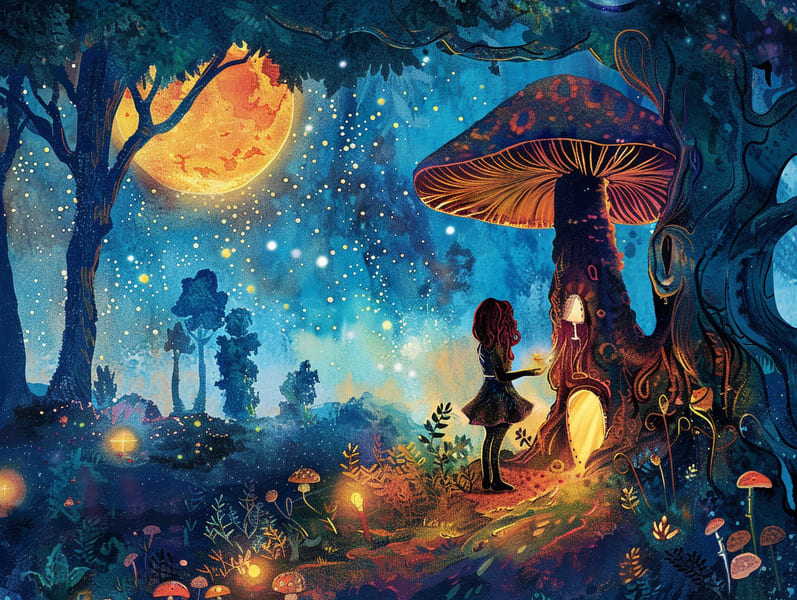
Legendary fairy tales have deep roots. These tales have been recounted from one generation to the next millennia before they were ever published. They came from a variety of traditions, including Western traditions. They were initially passed along among elders, often carrying themes and messages related to the societal norms and beliefs of the time.
The renowned Brothers Grimm, Jacob and Wilhelm, were among the first to compile and publish many of these beloved fairy tales. Their collection, "Grimm's Fairy Stories," included stories like "The Story of Cinderella," "The Story of Hansel and Gretel," and "Snow White," which have since become classics in the world of children's fairy tales. Similarly, Hans Andersen's delightful fairy tales, such as "The Little Mermaid," and "The Duckling's Story," have stolen hearts worldwide, solidifying their place in the pantheon of treasured fairy tales.
Despite being ancient, these stories remain as significant as ever, especially as children's bedtime stories. These delightful tales are now available in many formats, including vibrantly illustrated books, magical animations, and internet fairy tales.
Their lasting appeal can be attributed to several whimsical characteristics:
Important Morals: Traditional fairy tales often provide important moral lessons. Stories like "The Shepherd Boy and the Wolf" teach the significance of honesty, while "The Tale of the Tortoise and the Hare" show the benefits of determination and modesty. These narratives offer the young clear distinctions between moral and immoral, developing their moral compass in a kind yet lasting way.
Empathy and Awareness: Fairy tales frequently involve characters facing challenges and struggles, motivating kids to understand with their struggles and celebrate their triumphs. For instance, "The Story of Beauty and the Beast" highlights the merit of seeing beyond the surface to know the real character of a soul, enhancing compassion and recognition.
Cultural Perception: Many old fairy tales are steeped in the cultural contexts from which they blossomed. Exploring these stories can provide enlightening views into different customs, cultivating a sense of global understanding and respect.
Creativity and Fantasy: The magical elements in traditional fairy tales—wizardry and magic—provoke children’s innovations. These stories take readers to magical realms, kindling imaginative dreams and a sense of mystery that persists a lifetime.
Old fairy tales are not only bewitching but also informative. They work as enchanted tools in enhancing various cognitive and emotional skills in kids. When ancient fairy tales are spoken out loud, they cultivate verbal skills by presenting new word meanings and sophisticated sentence structures. This practice also enhances hearing abilities and focus, as little ones follow the story, looking forward to see what happens next.
Furthermore, conversing about the themes and characters of fairy tales can sharpen cognitive skills and problem-solving abilities. Young readers are guided to see patterns, guess what will happen, and catch on to cause and effect. These contemplations also encourage the young voice their thoughts and feelings, nurturing their emotional intelligence.
In today’s information age, the prevalence of online fairy tales has made these stories more obtainable than ever. Web platforms and web apps make available huge assortments of famous fairy tales that can be browsed or listened to anytime, anywhere. Fairy tales recited are particularly widespread, supplying an immersive method for kids to be a part of these mesmerizing stories. Read-aloud stories and narrated videos carry characters and settings to life, often enhanced by fantastical audio effects and harmonies that intensify the story journey.
The timeless appeal of ancient fairy tales online fairy tales for free lies in their ability to shift to modern times while keeping hold of their essential themes. Contemporary versions of these fairy tales often spotlight more diverse protagonists and modern settings, making them relevant to today’s audience. However, the central morals of guts, humanity, and fair play remain unchanged, continuing to strike a chord with young listeners of all ages.
Timeless fairy tales also offer a sense of comfort and recognition. They grant a tidy narrative with a apparent beginning, middle, and end, often concluding with the conclusion of conflicts and the triumph of virtue over vice. This regularity can be reassuring for young ones, granting a sense of consistency in an dynamic world.
Old fairy tales continue to charm and inform new generations, maintaining their delight and value in modern society. As bedtime stories for kids, they highlight a perfect blend of wonder and wisdom, developing moral values, empathy, and creativity. The prevalence of internet fairy tales and the sought after status of fairy tales told out loud ensure that these old fairy tales remain attainable to new generations.
By retaining and circulating these narratives, we continue to esteem the rich tapestry of tradition and cultural heritage. Whether you are accessing a gorgeously illustrated book, exploring a online library, or hearing an spoken story, the spell of timeless fairy tales is always within reach. These tales illustrate of the unceasing magic of tales and its ability to hold us together across generations and cultures.
Regardless if you are discovering a vividly illustrated book, exploring a digital collection, or listening through an read-aloud book, the spell of famous fairy tales is always within reach.
These fairy tales emphasize of the unceasing ability of narratives and its ability to gather us across epochs and places, casting a charm that delights and instructs alike.
Comments on “The Evolution of Ancient Fairy Tales and Their Consistent Charm.”